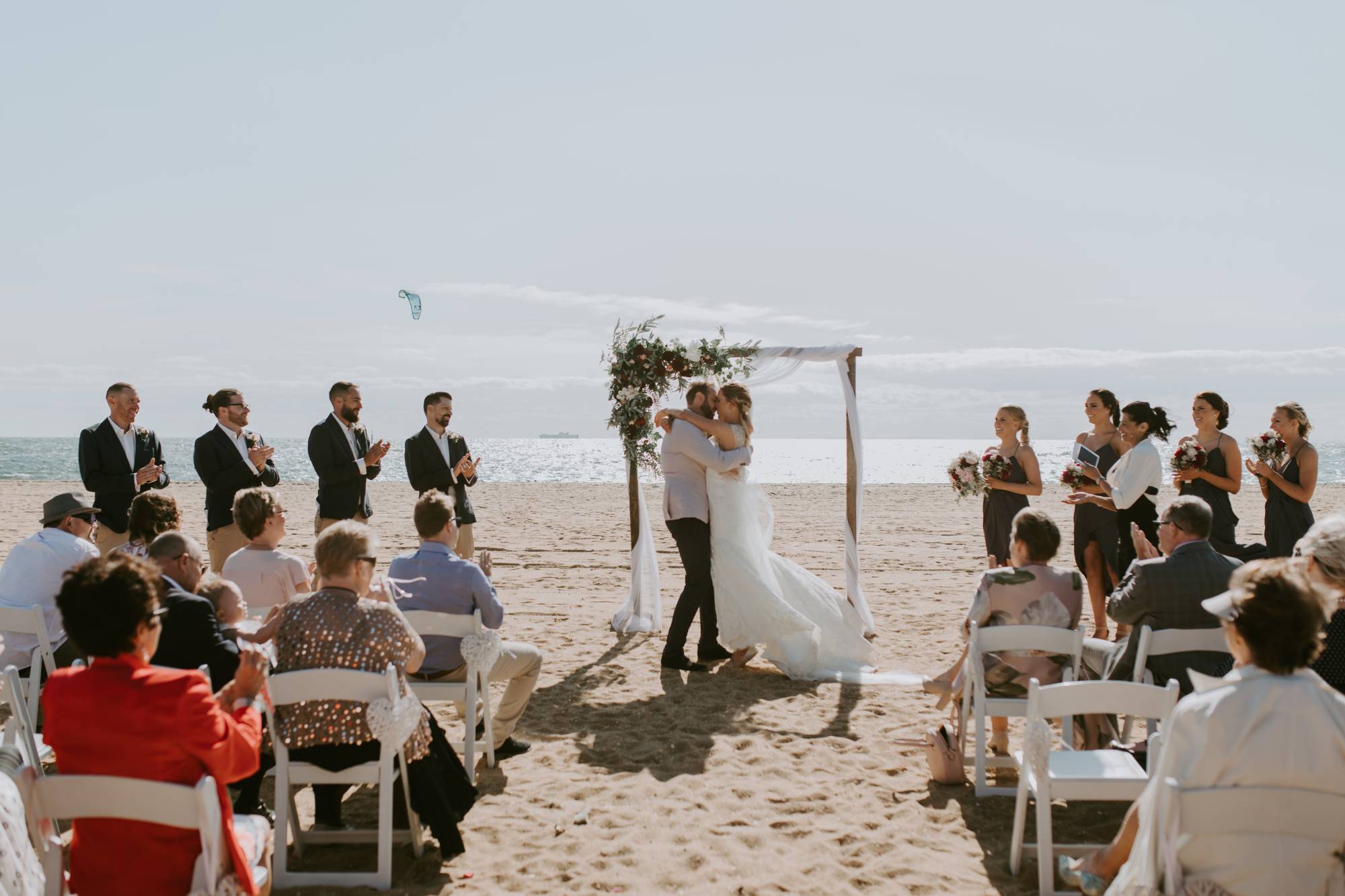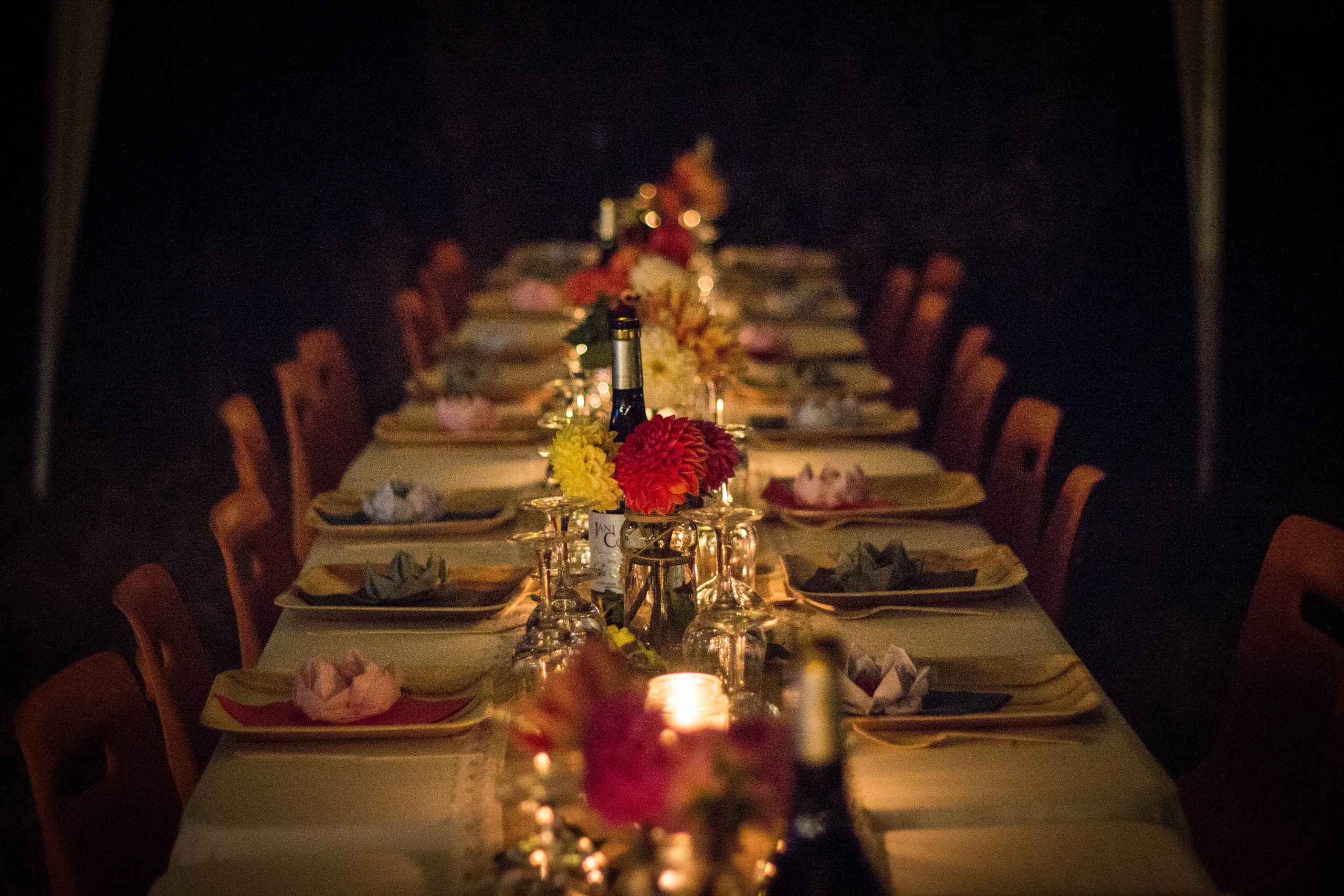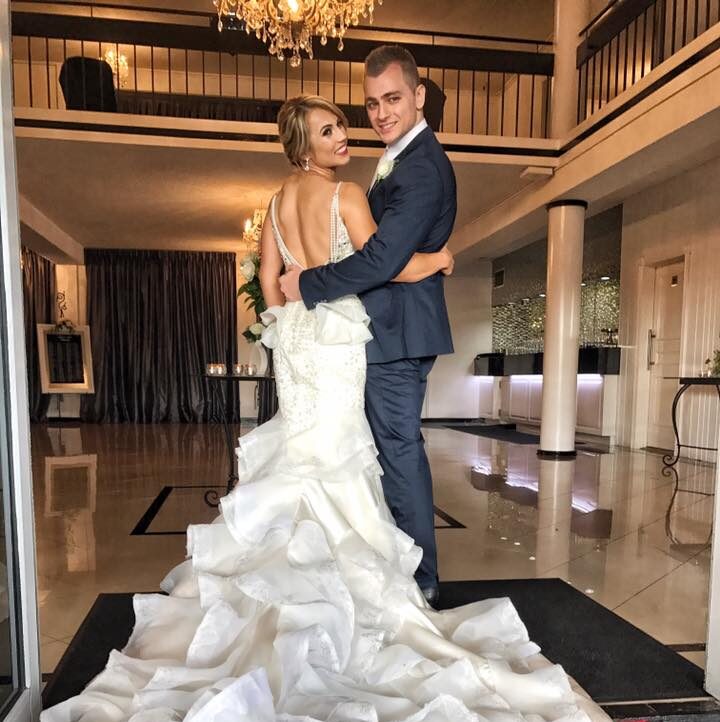Planning a wedding doesn’t need to mean going over budget. If you want an intimate celebration that still feels like a dream, a small wedding could be the perfect fit. I’ve worked with couples in Melbourne who’ve saved thousands by cutting down the guest list and focusing on what truly matters to them. The result? A memorable day that wasn’t weighed down by unnecessary costs. With the right approach, you can create a beautiful wedding that’s big on love and light on spending. Consider exploring small wedding packages to find the best options for your dream day.
Why Small Weddings Are the Perfect Choice for Couples on a Budget
When I got married in 2017 at Vogue Ballroom, I experienced the full-scale wedding process – the planning, the guest list, the expenses that kept piling up. But over the years, I’ve come to realise that sometimes, smaller weddings offer the best value. And they’re becoming a growing trend in Melbourne and across Australia.
If you’re looking to cut costs but still want a memorable day, a small wedding might just be the answer. The biggest advantage? Fewer guests mean fewer expenses. For example, a smaller guest list can drastically reduce catering costs. A friend of mine recently held a beautiful beach wedding in Port Phillip Bay with just 30 people.
The savings they made on catering, venue costs, and even decorations allowed them to splurge on their photography and make the day extra special without going overboard.
The Rise of Intimate Weddings
More couples are opting for small, intimate weddings. From my experience working with Melbourne couples, many realise that a smaller guest list doesn’t mean skimping on the experience. It means more opportunities for personal touches and unique elements. For example, a couple I worked with last year had their ceremony at a quirky Fitzroy warehouse.
They had a small guest list of 40 and used the savings to hire a renowned jazz band, creating an atmosphere that was uniquely theirs.
Benefits Beyond Cost
While cost savings are a significant draw, small weddings come with added benefits. They allow for a deeper connection with your guests. A smaller group means more personal interaction, and the experience feels more intimate. Imagine a wedding where you truly get to speak with every guest – this is often lost when you’re managing hundreds of people.
From a planning perspective, smaller weddings are much easier to manage. You won’t find yourself scrambling to accommodate last-minute changes for an entire guest list. You’ll also have more time to focus on what really matters – creating the day that reflects you and your partner’s personality.
How Much Does a Small Wedding Cost in Australia?
When it comes to wedding costs in Australia, it’s easy to get overwhelmed by the numbers. The average wedding in Australia in 2024 can set you back anywhere from $36,000 to $51,000, depending on the location and number of guests. But here’s the thing: you don’t need to spend a fortune to have a beautiful wedding.
From my experience, couples who opt for a small wedding can easily cut that figure in half, and sometimes even more. For instance, I recently worked with a couple in Melbourne who originally planned for a guest list of 150. After scaling it back to just 40 people, they managed to pull off an incredible wedding for $18,000, saving thousands without sacrificing the experience.
Average Wedding Costs Across Australia
Wedding costs vary widely depending on where you’re getting married. Here’s a quick snapshot of average wedding costs across different states:
- New South Wales: Average wedding cost: $36,000 | Venue cost: $15,000
- Victoria: Average wedding cost: $32,000 | Venue cost: $14,000
- Queensland: Average wedding cost: $30,000 | Venue cost: $13,000
- Western Australia: Average wedding cost: $28,000 | Venue cost: $12,000
- South Australia: Average wedding cost: $27,000 | Venue cost: $11,500
When it comes to small weddings, you can easily cut venue and catering costs by opting for a smaller venue or even a backyard ceremony. For example, a couple I worked with in regional Victoria chose a rustic vineyard with a guest list of just 50. Their total spend came to around $15,000, and it was just as stunning as any large celebration.
How Small Weddings Slash Your Wedding Budget
The major costs that drive up wedding prices are usually venue, catering, and the number of guests. By reducing your guest list to under 50 people, you can see a significant reduction in these expenses.
Let’s break it down:
- Venue: Smaller venues are more affordable, and you can even explore non-traditional options like art galleries, small wineries, or even private backyards. For example, a local couple in Melbourne saved a ton by hosting their ceremony at a community hall. It was simple but elegant, and the money they saved went into making the reception unforgettable.
- Catering: Catering for 100 people is far more expensive than catering for 30 or 40. With fewer mouths to feed, you can invest in higher-quality food, whether it’s a gourmet sit-down meal or a fun grazing table with local produce. The options are endless and can be tailored to your style without blowing your budget.
At the end of the day, a small wedding can still feel just as special and memorable as any larger one, without the financial strain. By trimming the guest list and focusing on key areas that matter most to you, the costs drop, but the quality and love of the day remain high.
Key Factors That Affect Small Wedding Costs
When you’re planning a small wedding, there are a few key factors that can make or break your budget. While the guest list is the most obvious place to save, there are a few other areas that can help you keep costs in check without sacrificing quality.
Guest List Size
The number of guests you invite is by far the most important factor in determining your overall wedding cost. Every additional guest adds up, especially when it comes to catering and venue costs. Cutting down on your guest list, even just by a few people, can save you hundreds, if not thousands, of dollars.
I’ve worked with couples in Melbourne who managed to save significantly by keeping their guest lists small. One couple I helped reduced their guest count from 120 to 50 people, saving almost $10,000 on catering and venue fees alone. It’s a simple change but one that can make a huge difference to your budget.
Venue Selection
The venue is often the largest expense for a wedding, but choosing a smaller or non-traditional venue can drastically cut costs. Think outside the box – local parks, art galleries, or even a family member’s backyard can provide a beautiful setting for a small wedding, and they often come at a fraction of the price of larger, traditional venues.
For example, a couple I worked with recently hosted their wedding in a small vineyard in regional Victoria. The venue was stunning and perfect for their intimate ceremony. Their venue cost was about $5,000, half the cost of larger, city-based venues. Not only did this save money, but it also made the day feel more personal and unique.
Season and Timing
The timing of your wedding can also have a major impact on costs. Weddings during peak seasons, like summer or around the holidays, are generally more expensive. However, by choosing an off-peak time, such as winter or a weekday, you could get a better deal on your venue and suppliers.
I’ve seen Melbourne couples cut costs by opting for a Friday or Sunday wedding, which typically costs less than a Saturday. Additionally, planning your wedding in winter when demand is lower can also provide opportunities to book vendors and venues at discounted rates.
Wedding Expenses Breakdown: What You’ll Spend on Your Small Wedding
When planning a small wedding, it’s important to understand where your money will go. Even with a reduced guest list, there are still a few essential expenses that can add up. The key is to prioritise what matters most to you and find creative ways to save where possible.
Venue and Catering
For small weddings, venue and catering will likely make up the bulk of your budget. The good news? With fewer guests, your costs in these areas can be a lot more manageable. A smaller guest list means fewer meals to pay for, which directly reduces your catering bill.
I recently worked with a couple who hosted their wedding at a quirky venue in the heart of Melbourne, where they had just 40 guests. The venue cost them $6,000, including food and drink, which was a huge saving compared to booking a large ballroom. They also opted for a buffet-style meal, which helped keep the catering costs lower.
If you’re looking for even more savings, consider a self-catered wedding or a non-traditional option like food trucks or grazing platters, which can be more affordable while still offering variety and quality.
Photography and Videography
While it’s tempting to cut costs in this area, photography and videography are two of the most important investments you can make. A professional photographer will capture your memories for years to come, so it’s worth budgeting for this service. On average, couples in Australia spend around $3,400 on photography, and $3,300 on videography, but it’s possible to get high-quality services for less, especially when you’re working with a smaller guest list.
For a small wedding, you can often negotiate with photographers to reduce their hourly rates. I helped a couple hire a talented photographer who did an excellent job for $2,500, even though they had a much smaller wedding. Shorter coverage and a more focused day can keep the costs down while still capturing all the special moments.
Entertainment
Entertainment costs for weddings can vary greatly, depending on whether you opt for a live band or a DJ. But for small weddings, you don’t necessarily need a big-budget band. In fact, some couples opt for a curated playlist or a solo musician, which can help keep costs down.
For a couple I worked with in St Kilda, they chose a local DJ for their 50-guest wedding, which cost around $1,500—far cheaper than hiring a full band. Alternatively, you could even curate a playlist on Spotify and hire a sound system for a fraction of the cost. For a smaller wedding, the music should match the vibe you want to create without blowing the budget.
Flowers and Decor
For a small wedding, decorations and flowers are another area where you can save. You don’t need elaborate floral arrangements or large centrepieces. Instead, focus on a few key elements that will make an impact without costing a fortune.
One couple I helped opted for seasonal flowers—local blooms that were available in abundance at the time of their wedding. They spent around $1,000 on flowers, which covered their bouquet, buttonholes, and a few centrepieces. Choosing flowers that are in season is an easy way to save money. For decor, simple touches like candles, fairy lights, and DIY centrepieces can create a beautiful atmosphere without the hefty price tag.
Cost-Saving Tips for Your Small Wedding
One of the great things about small weddings is how many opportunities there are to save. With fewer guests and a more manageable event, you have the chance to invest in what really matters and cut back on areas that aren’t as essential. Let’s take a look at some of the best tips for saving money on your small wedding without sacrificing the overall experience.
1. Trim the Guest List
This is one of the most effective ways to save money. Each person you invite adds to your costs for food, drinks, and venue space. A small wedding with 30-50 guests allows you to invest more in the things that will make the day unforgettable—whether that’s a beautiful venue, a top photographer, or a gourmet meal.
I worked with a couple in Melbourne who started with a guest list of 120, but by trimming it down to 50 people, they saved over $7,000 on catering and venue costs alone. It’s a small change that can have a big impact on your budget.
2. Choose Off-Peak Dates
Weddings on Saturdays during peak season tend to cost the most, especially for venues. By choosing an off-peak date—perhaps a weekday or a winter wedding—you could save significantly on venue and vendor prices. Many venues offer discounts for weekday bookings, and suppliers often have more availability and lower rates in the off-season.
One couple I worked with got married on a Friday in June. By doing so, they reduced their venue cost by 30%, which made a huge difference to their overall budget.
3. DIY Where Possible
Don’t be afraid to get a little creative with DIY options. You can make your own wedding invitations, decorations, and even some aspects of the catering. For example, creating your own table centrepieces can save a lot compared to hiring a florist. Many couples also opt for DIY photo booths with props they’ve gathered themselves, adding fun without the extra cost.
A couple I helped decided to create their own wedding favours using small potted plants from a local nursery. They bought the plants in bulk, and it cost them just $300, compared to the average $1,000+ they would have spent on traditional wedding favours.
4. Opt for a Smaller, More Affordable Venue
If you’re getting married in a popular city like Melbourne, the venue can often be the most expensive item on the list. But there are many alternatives to traditional banquet halls. Consider a smaller, non-traditional venue like a boutique hotel, local park, or a friend’s backyard. These venues often come with a more affordable price tag and add a unique charm to the day.
For example, a couple I worked with hosted their ceremony in a charming local winery with a stunning view for just $5,500, significantly less than larger, more formal venues. They also chose to have the reception at a local café with a rustic atmosphere, saving money while creating a personalised and intimate setting.
5. Focus on What Matters Most
When planning a small wedding, it’s important to prioritise the things that matter most to you. Whether it’s an unforgettable photographer, a specific type of food, or a special venue, make sure you allocate your budget to these priorities. Once you’ve chosen the things that are most important, it’s easier to scale back in other areas.
For instance, a couple I worked with in Geelong prioritised their wedding photographer and spent around $3,500 on a highly recommended photographer, but chose a more affordable venue. Their photos turned out stunning, and they felt the investment was well worth it.
Hidden Costs to Look Out for When Planning a Small Wedding
Even with a small wedding, there are some hidden costs that can easily catch you off guard. While it’s easy to focus on the big-ticket items, such as the venue and catering, it’s the small, unexpected expenses that can sneak up on you. Here are some of the common hidden costs to be aware of when planning your small wedding.
Service Charges and Gratuities
Many venues and vendors will add service charges or gratuities to their final bills, which can sometimes be overlooked in the initial planning stages. These can range from 10-20% of the total cost, so it’s important to clarify any service charges upfront with your suppliers. I’ve worked with couples who had to adjust their budgets last minute because of unexpected service fees.
Make sure to ask if there are any additional service charges when you book your venue or vendors, and budget accordingly. A wedding planner can help negotiate these fees as well.
Alterations and Tailoring
Wedding attire, particularly the bride’s dress and the groom’s suit, often requires alterations. While these costs are sometimes included in the initial price, they can easily add up if you need extensive adjustments. One bride I worked with spent an additional $500 on alterations to her dress, which was a budget surprise she hadn’t anticipated.
Always factor in alterations when budgeting for your wedding attire, and try to include them in your cost estimates early in the planning process.
Overtime Fees
Another hidden cost that many couples overlook is overtime fees. If your wedding reception runs longer than expected, many venues or suppliers will charge for extra hours. This is especially important to consider if you plan to have an extended celebration. I once helped a couple in Geelong whose reception ran an extra two hours past their booked time, and they ended up paying an additional $1,200 for venue and staff overtime.
To avoid this, make sure your timeline is realistic and clear with all your suppliers about when services will end. If you do expect an extended reception, discuss the potential for overtime costs upfront.
Marriage License and Legal Requirements
In Australia, you need to apply for a marriage license before your wedding day, and there may be additional legal fees depending on where you’re getting married. For example, in Perth, couples are required to pay $399 (Ex GST) to register their marriage, including the celebrant’s services and the legal process.
Be sure to check the specific requirements for the location of your ceremony and include this in your budget from the start.
Vendor Meals
It’s easy to forget that vendors, such as photographers, videographers, and musicians, will need to eat during the event. Many couples don’t realise that catering for vendors often comes with an extra cost. This can range from $20 to $50 per vendor, so if you’ve hired a photographer and a DJ, the cost can quickly add up.
Check with your catering team to see if they offer vendor meals as part of the catering package, or if you’ll need to arrange separate meals for your suppliers.
Wedding Planning Tools to Keep Your Small Wedding Budget on Track
Managing your wedding budget can be tricky, but the right tools can make it much easier. Whether you prefer apps, spreadsheets, or vendor comparison websites, these resources can help you stay organised and avoid overspending.
1. Budgeting Apps
Wedding-specific apps like The Knot and WeddingHappy help you track spending by category and send reminders for upcoming payments. A couple I worked with used WeddingHappy to stay organised and stick to their $20,000 budget.
2. Excel Spreadsheets
If you prefer spreadsheets, they’re a great way to break down costs by category. One couple created a simple spreadsheet, comparing quotes and tracking payments, which kept them on budget and helped them make smarter decisions.
3. Vendor Comparison Websites
Websites like Easy Weddings and Oneflare allow you to compare vendor prices and read reviews, helping you find affordable options. A couple I worked with saved $500 on their photographer by comparing quotes online.
4. Wedding Budget Templates
Free budget templates, like those from Mint or Bridal Guide, are helpful for organising your expenses and tracking your progress. These templates provide a clear overview of typical wedding costs and allow you to customise your budget.
5. Wedding Planner Consultation
Even if you’re planning a small wedding, a wedding planner’s expertise can save you time and money. A couple I helped secured a venue discount by consulting a planner for just a few hours.
Planning a small wedding doesn’t have to be overwhelming or expensive. By keeping your guest list short, choosing an affordable venue, and prioritising the elements that matter most to you, you can create a memorable day without the financial strain.
The key is to stay organised, make smart decisions, and remember that it’s not about how many guests you have or how lavish the decorations are—it’s about the experience and the love you’re celebrating.




